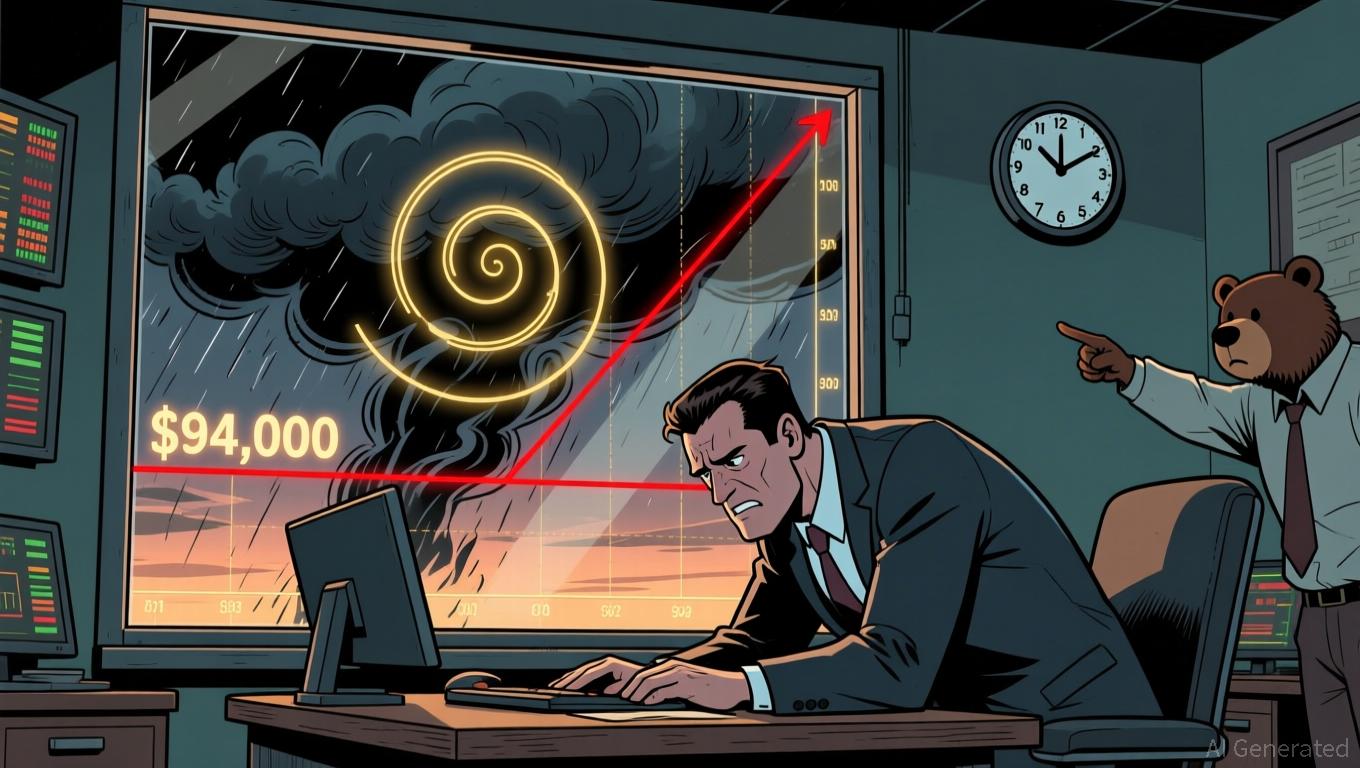Bitcoin News Today: Is Bitcoin’s $94,000 Level a Temporary Mid-Cycle Halt or an Indication of Capitulation?
- Bitcoin fell below $100,000, intensifying focus on the $94,000 support level as technical models suggest potential decline to $86,000 if this threshold breaks. - Institutional selling and ETF outflows ($870M in one day) highlight waning demand, compounded by a strong dollar index (DXY 99.58) and bearish on-chain data. - Market sentiment deteriorated (Fear & Greed Index at 16), with put options trading at premiums and altcoins like Ethereum mirroring Bitcoin’s weakness. - Analysts remain divided: some vie
Bitcoin's recent dip beneath the $100,000 mark
From a technical perspective, some analysts highlight the Wyckoff distribution pattern as a bearish signal, indicating

The $94,000 mark, which is the average entry price for holders over the past 6–12 months, has become a central focus. A decisive drop below this level would signal a change in market sentiment and could spark a deeper correction.
Institutional appetite has also waned, with U.S. spot Bitcoin ETFs seeing significant withdrawals.
Retail and derivatives markets are echoing the caution seen among institutions.
Experts remain split on the broader outlook. Some believe the $94,000 level is only a temporary obstacle, while others caution that continued institutional selling could lead to a more pronounced downturn.
If Bitcoin falls through $94,000, the next significant supports—$91,000 (2x Metcalfe Network Value band) and $72,000 (Traders' minimum price band)—may be tested. On the other hand,
Disclaimer: The content of this article solely reflects the author's opinion and does not represent the platform in any capacity. This article is not intended to serve as a reference for making investment decisions.
You may also like
AI-Generated Algorithms and Human Interaction: The Internet's Trustworthiness Dilemma
- The "Dead Internet Theory" resurfaces as AI-generated content dominates online platforms, blurring human engagement metrics. - Pixalate's Q3 2025 data reveals 37% non-human traffic in Brazilian mobile app ads, highlighting ad viewability crises. - C3.ai's 19% revenue drop and $117M loss underscore AI sector risks from high costs and competitive pressures. - Advertisers face unreliable metrics as algorithmic noise grows, prompting calls for stricter regulations and advanced analytics.

Ethereum Latest Updates: Major Institutions Support Ethereum's Supercycle, While Technical Experts Raise Concerns
- Tom Lee predicts Ethereum's "supercycle" driven by institutional adoption and DeFi growth, sparking market debate over valuation risks. - SharpLink Gaming's 1,100% revenue surge and $200M ETH allocation to Linea highlight bullish institutional strategies amid price volatility. - Technical analysts warn ETH's $3,500 support is critical after breaking below key channels, with $37B daily volume reflecting mixed momentum. - Growing institutional demand contrasts with critics' concerns over centralization ris

The Rapid Rise of ZEC (Zcash) Value: An In-Depth Technical and Strategic Analysis
- Zcash (ZEC) surged 66.55% in November 2025, peaking at $683.14, driven by treasury initiatives, privacy innovations, and institutional investments. - Cypherpunk Technologies' $50M treasury and Zashi Wallet's privacy swaps boosted demand, while Winklevoss Capital and Grayscale added $72.88M in institutional backing. - Technical indicators show overbought conditions (RSI 94.24) but bullish momentum persists, with derivatives markets holding $1.13B in open interest and a 1.06 long-to-short ratio. - Zcash's

ICP Caffeine AI's Rising Popularity: Ushering in a New Age for Blockchain Investors and AI-Powered DeFi
- Dfinity's ICP Caffeine AI bridges blockchain and AI in 2025, enabling non-technical users to build dApps via natural language prompts. - The platform saw 30% ICP token price growth and $237B TVL in Q3 2025, but faced 22.4% dApp usage decline amid market saturation. - Investors prioritize infrastructure projects like ICP Caffeine AI for AI-driven DeFi scalability and security, contrasting with speculative token trends. - Regulatory scrutiny and user retention challenges persist, but enterprise adoption of
